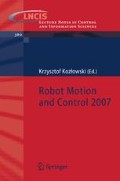Abstract
An environment where virtual worlds coexist with real worlds, mixed reality, has been extensively studied in the last decade. Milgram’s definition of the Reality-Virtuality Continuum [8] focuses on display technology such as head-mounted displays. However, people still feel the gap between mixed reality environments supported only by display technology and those closely integrating physical reality [10].We do not restrict mixed reality to a mixing of visual images or sounds, but include other phenomena (e.g., electric, mechanical, hydraulic, aerodynamic, thermodynamic). Mechatronic technology can be used to enhance physical usability in mixed reality. Bond graphs, originated by Paynter [2] and further developed by Karnopp [3], are domain independent graphical descriptions of the dynamic behavior of physical systems. Amerongen [6] emphasized that the energy-based approaches toward the design of mechatronic systems allow the construction of reusable and easily extendible models. Bruns [4] introduced a universal interface for mixed reality using bond graphs, called hyper-bond. An improved hyper-bond was presented by Yoo and Bruns [5]. A real energy dynamics can connect with a virtual energy dynamics via an improved hyper-bond interface providing relevant functionalities such as preservation of power balance, causality reasoning of a connection between real and virtual subsystems, stability, and quality. This paper presents a new methodology of mixed reality design, called mixed reality bond graph, in which the modeling methods of real energy dynamics, virtual energy dynamics, and hyper-bond interfaces can be combined seamlessly. A distributed mixed reality haptic ball manipulator, as an example using the mixed reality bond graphs, is demonstrated.
Access this chapter
Tax calculation will be finalised at checkout
Purchases are for personal use only
Preview
Unable to display preview. Download preview PDF.
References
Salisbury K, Conti F, Barbagli F (2004) Haptic Rendering: Introductory Concepts, IEEE Computer Graphics and Applications, 24-32
Paynter H M (1961) Analysis and Design of Engineering Systems. MIT Press, Cambridge, MA
Karnopp D C, Margolis D L, Rosenberg R C (1975) System dynamics, a unified approach. John Wiley, New York
Bruns F W (2001) Hyper-Bonds (Enabling Mixed Reality). artec-paper, Bremen University, 82
Yoo Y H, Bruns F W (2006) Energy Interface for Mixed Reality. Proc. 12th IFAC Symposium on Information Control Problems in Manufacturing, Saint Etienne
Amoerongen J V, Breedveld P (2004) Modelling of Physical Systmes for the Design and Control of Mechatronic Systems.IFAC, Professional Brief, Oxford, UK
Smith R (2004) Open Dynamics Engine v0.5 User Guide. ode.org, http://ode.org
Milgram P, Kishino F (1994) A taxonomy of mixed reality visual displays. IEICE Trans. Information Systems, E77-D:12
Bruns F W, Erbe H -H (2005) Mixed Reality with Hyper-Bonds. Control Engineering Practice, Elsevier
Ishii H, Ullmer B (1997) Tangible bits: towards seamless interfaces between people, bits and atoms. Proc. CHI ’97, 234-241
Yoo Y H (2007) Mixed Reality Design Using Unified Energy Interfaces. Dissertation, FB3, University of Bremen, Germany
Author information
Authors and Affiliations
Editor information
Editors and Affiliations
Rights and permissions
Copyright information
© 2007 Springer London
About this paper
Cite this paper
Yoo, YH. (2007). An Energy-Based Approach Towards Modeling of Mixed Reality Mechatronic Systems. In: Kozłowski, K. (eds) Robot Motion and Control 2007. Lecture Notes in Control and Information Sciences, vol 360. Springer, London. https://doi.org/10.1007/978-1-84628-974-3_16
Download citation
DOI: https://doi.org/10.1007/978-1-84628-974-3_16
Publisher Name: Springer, London
Print ISBN: 978-1-84628-973-6
Online ISBN: 978-1-84628-974-3
eBook Packages: EngineeringEngineering (R0)

